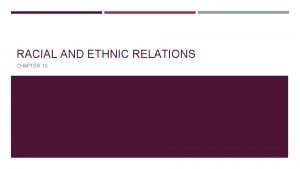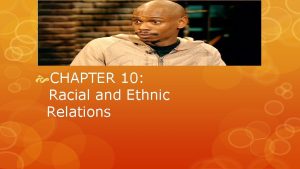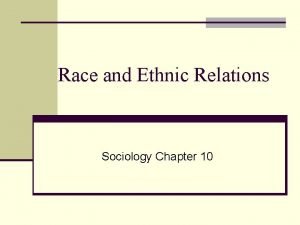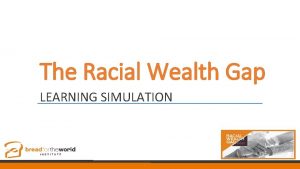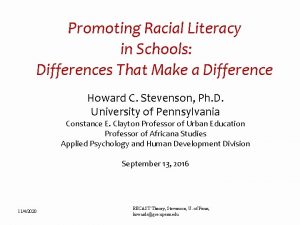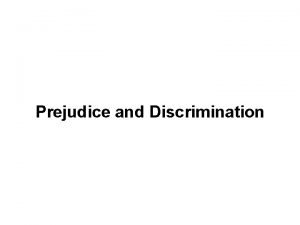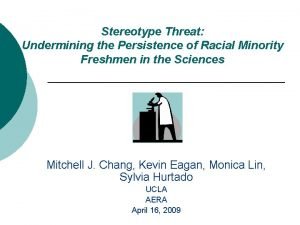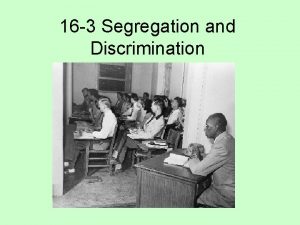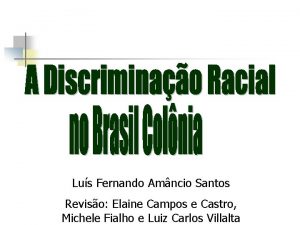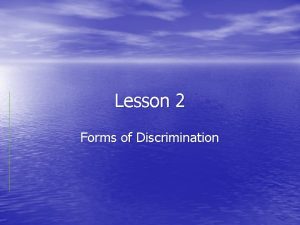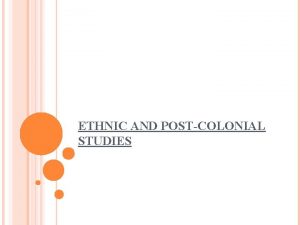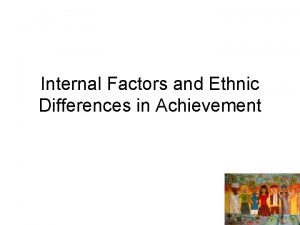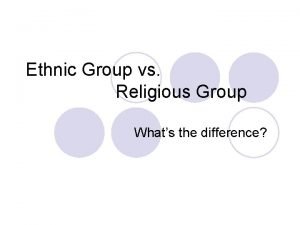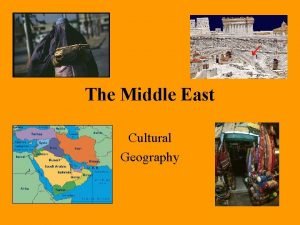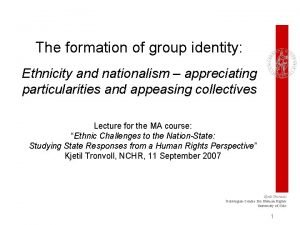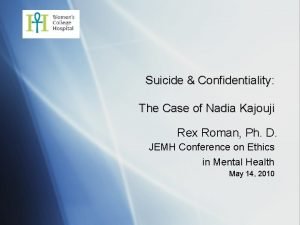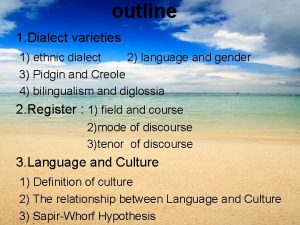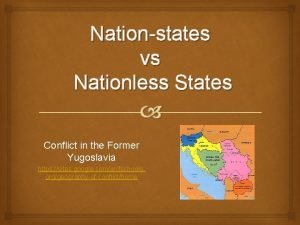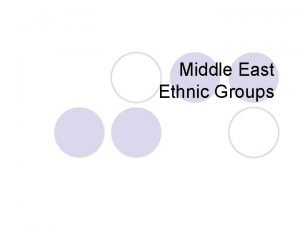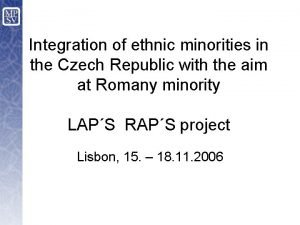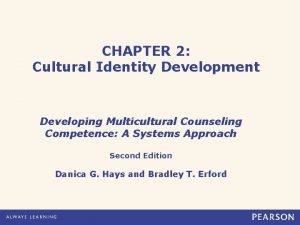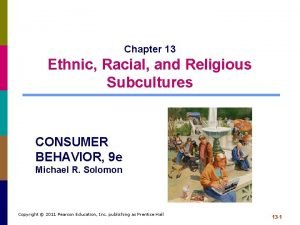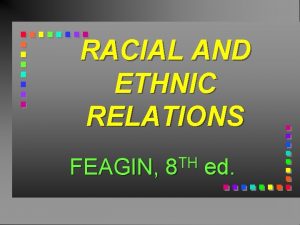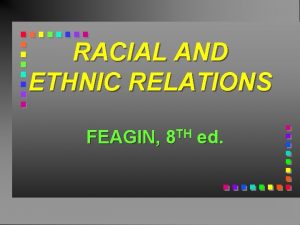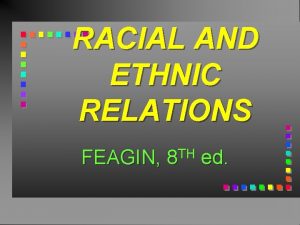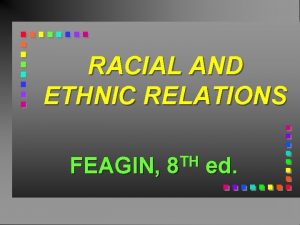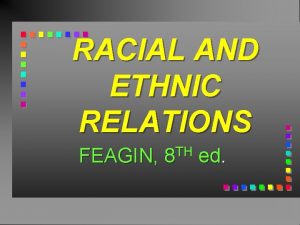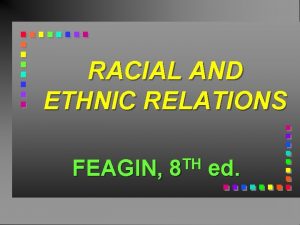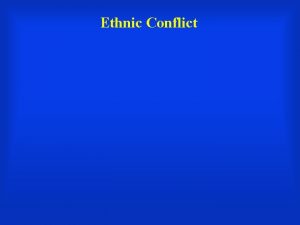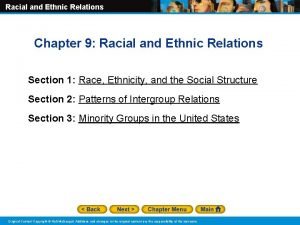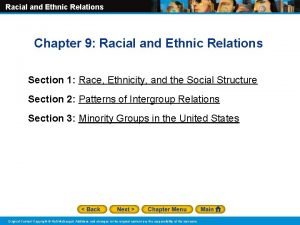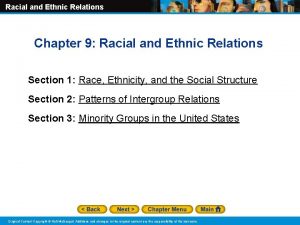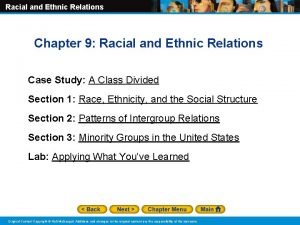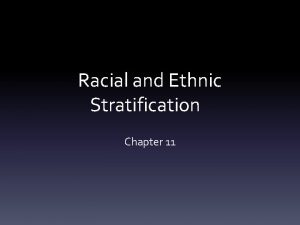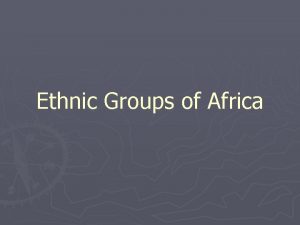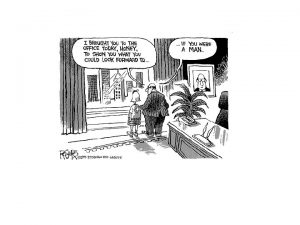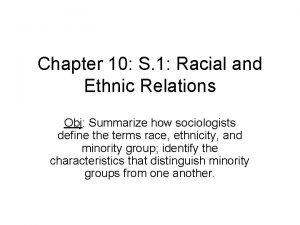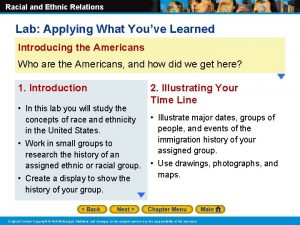RACIAL AND ETHNIC RELATIONS FEAGIN TH 8 ed




































- Slides: 36

RACIAL AND ETHNIC RELATIONS FEAGIN, TH 8 ed.

JAPANESE AMERICANS CHAPTER 10

INTRODUCTION: ASIAN AMERICANS • Asian American & Asian-Pacific American • • Umbrella terms for Americans with ancestral roots in Asia or the Pacific Islands Changes in U. S. immigration laws since 1965, especially elimination of openly discriminatory immigration quotas, allowed substantial increase in immigration from Asia and Pacific Islands

JAPANESE AMERICANS • • Now more than 1. 2 million and one of oldest Asian American groups Model Minority Stereotype • • • Characterizes certain Asian American groups as exemplary in socioeconomic and moral characteristics, often as compared to other people of color Most heavily concentrated in western states Still conjure racial stereotypes as “crafty Orientals” and of militaristic expansionism in 1930 s

MIGRATION: AN OVERVIEW • • Asian and Pacific Americans include many immigrant groups Historically, immigration of early Asian groups proceeded serially • • Result of white employers seeking new laborers and of white workers motivated by racist prejudices to stop immigration by a particular Asian worker group Prevention of Chinese immigration in 1880 s • Japanese workers aggressively recruited to fill demand

* This category includes census estimate from survey for people who reported only one specific Asian Group. ** This category includes census estimate from survey for people who reported one detailed Asian group plus people reporting two or more Asian groups and people who reported some Asian and some non-Asian ancestry.

Early Immigration • Gunboat Imperialism • • • Imperialism backed by the use or threat of military force Japan’s initial contact with U. S. Hawaii became first destination for Japanese immigrants in U. S. • • 231, 000 migrated there between 1869 and 1929 Became part of racial hierarchy headed by white planters Learned they could not “advance themselves through individualism and small business” as on the mainland Became laborers and adopted strategy of “unionization, politics, and collective action”

Mainland Migration • Between 1880 s and Gentleman’s Agreement in 1908 • • • Mainland immigrants moved into greater diversity of economic positions White employers favored labor immigration • • More than 150, 000 entered White workers and unions opposed it Unlike earlier Chinese immigrants, Japanese were able for a time to bring in families

More Racist Agitation and Restrictions • White writers and politicians expressed fear of Asian immigrants • The American Legion and California Farm Bureau Association pressed for exclusion • Congress succumbed and passed 1924 Immigration Act • • • Established racist quotas that gave preference to “Nordic” countries Government action against Asians spurred by white-controlled labor unions Japanese largest group of about 1 million in 1965

STEREOTYPES • • Stereotypes of Asian Americans take variety of forms Robert Lee – “Six Images” • • • “Pollutant, ” “coolie, ” “deviant, ” “yellow peril, ” “model minority, ” and “gook” Within short period, many early laborers gained farm land by contract or lease U. S. presidents, senators, and ordinary whites exaggerated differences between themselves and Japanese immigrants • U. S. movie industry played important role in circulation of stereotypes

• • War Propaganda Japanese considered “inferior race” with brashness to challenge European and American interests in the Pacific California attorney general and later U. S. chief justice Earl Warren depicted Japanese as dangerous • • • National press argued there were many enemy agents in this population No Japanese American ever proven to have collaborated with enemy during WWII Stereotypes slowly began to change after WWII

Recent Distortions, Stereotypes, and Omissions • Study of Japanese Americans in 1970 s found numerous distortions in history text books • • • Most omitted brutal exploitation by U. S. employers in Hawaii and California Japanese and other Asian Americans reported whites frequently congratulate them on how well they speak English as though they were foreign-born Racist imaging sometimes takes form of mocking language and cultures of Americans of color

• Debates about negative images in the media emerged again in early 2000 s • • Disney film “Pearl Harbor” use of derogatory epithet “Japs” and one-sided portrayal of WWII Examples of racial stereotyping • • • Senator Spark Matsunuga of Hawaii San Francisco radio station Toledo, Ohio radio station Rosie O’Donnell Adidas caricature of buck-toothed, slant-eyed Asian as logo • Such stereotypes are an integral part of old white racial framing of society

REPRESSION AND VIOLENT ATTACKS • Anti-Japanese movements sometimes turned to violence • • • First acts came within decade of their arrival Scientists sent by Japan to help with earthquake relief after San Francisco quake of 1906 attacked by white men Escalated at beginning of WWII • 1942, whites carried out attacks on Japanese Americans and their property

The Ugly Specter of U. S. Concentration Camps • Japanese military victories in the Pacific increased fear of Japanese invasion on the mainland • 1 st major phase of federal action • • • Americans whose ancestry linked to countries at war with U. S. were moved from sensitive areas and their travel restricted Japanese American businesses sold at a loss In 1942, more than 2/3 rds Japanese housed inland were native-born U. S. citizens • Protested their discrimination in numerous demonstrations

Why the Camps Were Created • U. S. Supreme Court upheld military decision though clear violation of constitutional civil rights • • • American leaders saw struggle in the Pacific as a racial war Japanese fought unsuccessfully in courts and with demonstrations Highly racialized oppression of U. S. citizens occurred at a time when U. S. government was proclaiming values of freedom and democracy to a war-torn world

• Later Impact After WWII, most Japanese returned to west coast • • • Faced economic discrimination and violent attacks Fastest-growing category of hate crimes in recent decades has been against Asian Americans Lieutenant Ehren Watada • • Protested Gulf War in that it violated U. S. and international law Connected his conscientious stand with those of concentration camp era who actively stood up against oppression

THE POLITICAL ARENA • • Japanese American Citizens League (JACL) Since WWII, JACL and other organizations won political and legal victories Organizations continued to press government for adequate repayment for losses 2001, memorial to incarcerated Japanese Americans and soldiers who served in military was dedicated in Washington, D. C.

Government Officials • • • Japanese elected to Hawaiian state legislature led to statehood of islands in 1950 s Political victories on mainland difficult because of dilution of Japanese votes in predominantly non-Asian populations Historically, many Asian Americans reluctant to participate actively in politics • • Fear of intensifying discrimination against their groups Japanese and other Asians who enter political arena encounter overt racist reactions

Politics, Stereotyping, and Competition with Japan • Acts of vandalism and violence by whites against Japanese motivated by fear of economic competition with Japan • • • Recently, Japan’s economic development has surpassed U. S. in many areas Increasing unemployment in local and national recessions periodically fueled tendency to blame Asians for U. S. economy Anti-Japanese hostility among non-Asians can still turn to threats of violence today

Protest Organizations and Group Pride • Voluntary associations formed in early 1900 s to combat anti-Japanese discrimination • 1960 s Pan-Asian organizations appeared, established by younger generations • Numerous colleges and universities developed Asian American studies programs • Yet recently, hate crimes directed against Asians persist on campuses

THE ECONOMY • First four generations of Japanese • • Most early immigrants came from eleven Japanese prefectures which were represented by an association in U. S. 1913 California Alien Land Law • • Issei (born in Japan), Nisei, Sansei, and Yonsei Issei played “middleman minority” role Stipulated aliens could not buy or lease land for more than 3 years Often became gardeners or nursery operators

• • Japanese American women labored along with men to secure their own and their families’ livelihood Some worked as domestic servants to whites • • Resisted oppression in covert ways As need for labor grew after WWII, white employers finally began to hire Japanese • Second and later generations gradually moved from small business economy to professional and other white-collar jobs

Occupational Mobility • Income data reveal economic success • Yet, they face exclusion from certain positions in many businesses, entertainment, political, and civil service areas • Glass Ceiling • An unwritten and unofficial policy in some organizations that limits the potential for advancement of certain persons, usually based on their race or gender

EDUCATION • • Issei had strong commitment to education Japanese Americans developed their own schools to educate children in the Japanese language and culture • • • By 1930 s, making great strides despite discrimination Wartime imprisonment interrupted educational pursuits Japanese among the most educated Americans

RELIGION • • • Immigrants brought Buddhism and Shintoism 1920 s white exclusionists claimed temples were areas of emperor worship Today, many are members of Protestant churches • • Churches second in importance to family in cementing the community Resurgence in Buddhism in recent years among Asians and non-Asians

ASSIMILATION PERSPECTIVES • • Japanese Americans the most assimilated to Euro-American core culture of all Asian groups Assimilationists argue that some cultural assimilation came early for Issei • • • 2 nd generation Nisei became bi-cultural 3 rd generation Sansei closed gap with some aspects of dominant culture 3 rd and 4 th generation highly oriented to norms and styles of white middle-class culture and retained few Asian traditions

• • Structural assimilation at secondarygroup levels significant for Japanese Behavior-receptional and attitudereceptional assimilation showed little change until after WWII • • Discrimination and prejudice marred lives of Issei and Nisei for first 60 years By 1980 s whites did not see Japanese as very different from themselves • • High rate of intermarriage with whites Still experience subtle, blatant, and covert discrimination

• Asian-white marriages illegal until late 1940 s • • Out-marriage rates to whites high in California Numerous Asian Americans marry outside their own group yet marry interethnically to other Asian Americans Few have rejected their Japanese cultural heritage or identity Younger Japanese Americans retaining some of their distinctive organizations and traditions

• • While there are signs of significant acculturation to core culture, most hold values close to those of their parents In broad view of assimilation, Asians can be grouped into major categories based on: • • Degree of overall assimilation to dominant Eurocentric culture and institutions The strength of ethnic identity • • Japanese Americans in high assimilation, high ethnic identity category Hapa • The Hawaiian word for “those of mixed ancestry”

• • • Power-Conflict View Only few analysts interpreted Japanese American experience form power-conflict perspective Because U. S. was an imperial power in Pacific, U. S. labor agents had easy entry into Asian countries and could dictate labor agreements benefiting U. S. employers At first Japanese Americans forced by white-generated discrimination to become low-wage workers

• Pressure to acculturate largely coercive for first two generations • • Implicit bias in traditional assimilation model • • Early commitment to cultural assimilation in Japanese communities was reaction to severe racial discrimination Assimilation theory emerged in a period of intense white agitation against Japanese immigration and reflected racist views of white scholars U. S. government played role in defining racial groups

Criticizing the “Model Minority” Stereotype • • • Paramount weakness in assimilation analysis is reliance on a “model minority” Whites intentionally created model minority during period of African American protest to suggest that African Americans could achieve by working harder rather than protesting institutional discrimination Educational opportunities not available to blacks helped Asians to get white-collar jobs after the war

• Success came at the price of marginalization in small-business economy and later in certain professions • • Economic success result of carving distinctive niche, which is not in line with idealistic assimilation models Paul Takagi • Bias in traditional cultural background explanation • The idea that the racial and ethnic groups whose values are closest to those of the dominant white group are the ones who will be and should be successful

• Janice Tanaka • • • Nisei greatly affected by internment and placed pressure on themselves and their children to conform to white perspectives and customs Japanese immigration and Japanese American integration into dominant culture and society shaped by U. S. corporations’ intervention in world economy New economic alliances in the Pacific Rim are bypassing U. S.

• Japan is a powerful economy in these alliances • • • One reason why there has been relatively little recent migration from Japan to U. S. Some non-Asians, angry over domestic troubles, confuse Japanese Americans with other Asians and blame them unfairly for economic troubles caused by U. S. employers investing overseas For a time, Japan viewed as taking over U. S. by buying companies and real estate • Little attention given to fact that Great Britain and Canada largest foreign investors in U. S.
 Timid bigot example
Timid bigot example Chapter 10 racial and ethnic relations
Chapter 10 racial and ethnic relations Chapter 10 racial and ethnic relations review worksheet
Chapter 10 racial and ethnic relations review worksheet Feagin mill middle school
Feagin mill middle school Black studies and the racial mountain
Black studies and the racial mountain Employee relations in public relations
Employee relations in public relations Jim crow laws in what region or regions did it exist
Jim crow laws in what region or regions did it exist Racial wealth gap simulation
Racial wealth gap simulation Promoting racial literacy in schools
Promoting racial literacy in schools Anti imperialist league apush
Anti imperialist league apush Racial prejudice
Racial prejudice Don tiburcio
Don tiburcio Racial insults
Racial insults Chapter 16 section 3 segregation and discrimination
Chapter 16 section 3 segregation and discrimination Cartel ley organica contra la discriminacion racial
Cartel ley organica contra la discriminacion racial Democracia racial
Democracia racial Lesson 2 racial discrimination
Lesson 2 racial discrimination Ethnicity in postcolonialism
Ethnicity in postcolonialism Internal factors and ethnic differences in achievement
Internal factors and ethnic differences in achievement Whats an ethnic religion
Whats an ethnic religion How are ethnic groups and religious groups related
How are ethnic groups and religious groups related Is buddhism monotheistic or polytheistic
Is buddhism monotheistic or polytheistic Ethnic groups in the middle east
Ethnic groups in the middle east Ethnic boundary marker
Ethnic boundary marker Nadia kajouj
Nadia kajouj Madrid spain absolute location
Madrid spain absolute location Ethnic religions ap human geography
Ethnic religions ap human geography Ethnic religion examples
Ethnic religion examples Ethnic formation
Ethnic formation Ethnic dialect
Ethnic dialect Ethnic cleansing kosovo 1998
Ethnic cleansing kosovo 1998 Ethnic groups in the middle east
Ethnic groups in the middle east Brain wrinkles southwest asia
Brain wrinkles southwest asia Ethnic groups in czech republic
Ethnic groups in czech republic Is hinduism an ethnoreligion
Is hinduism an ethnoreligion Feminist identity development model
Feminist identity development model Ethnic subcultures
Ethnic subcultures
